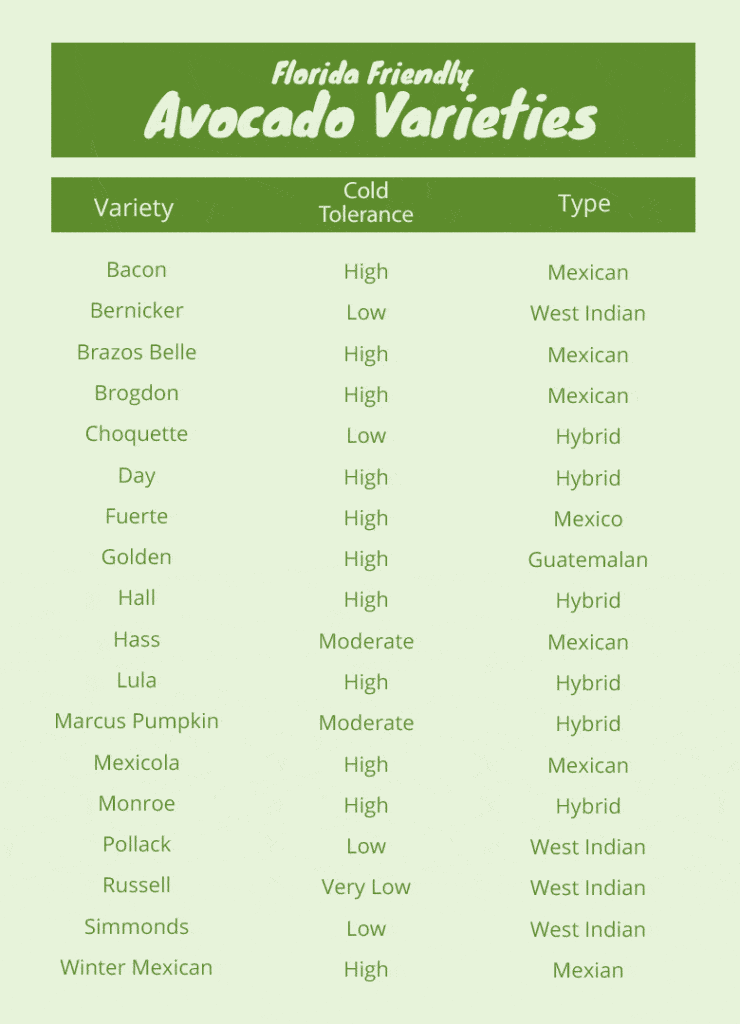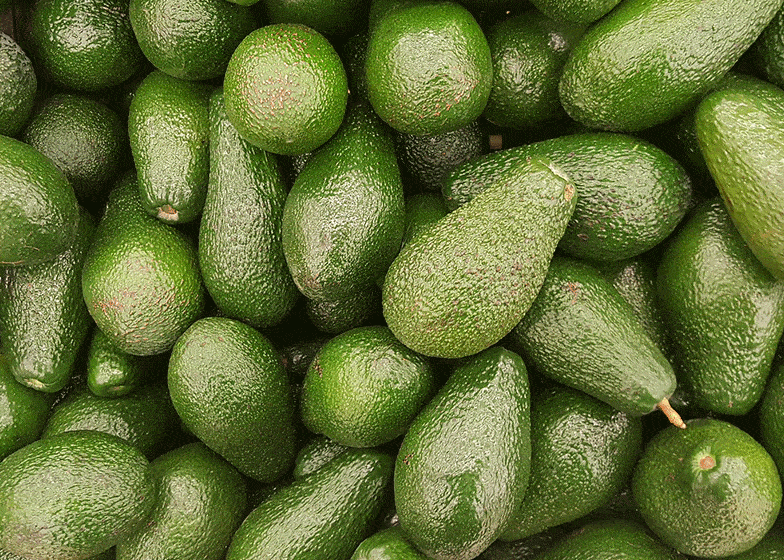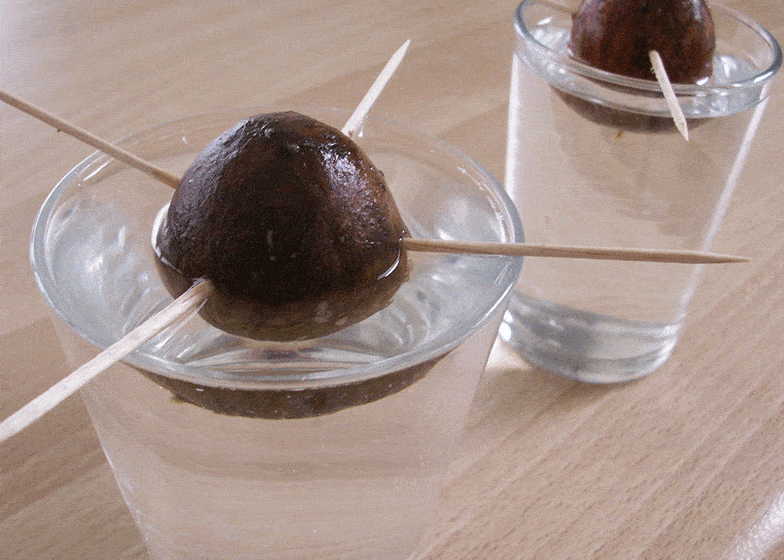Those living in the southern part of the state will have no problem growing avocados in Florida
Avocados grow best in warm climates. The southern and central parts of the state will have the best luck growing avocado trees. Those in north Florida will have to provide protection and choose cold-tolerant varieties. These can become large trees. Plant in an area with enough space, full sun, and well-draining soil. Avocados don’t mind Florida’s natural soil.
Avocados are tropical plants and prefer warm weather, rain and lots of sun. Most of Florida has plenty of this. There are a lot of varieties of avocados that we can grow here in Florida, your standard ‘hass’ avocado is just the tip of the iceberg.
Avocado Varieties That Will Grow In Florida
Popular Avocado varieties for Florida are Bermicker, Brogdon, Choquette, Day, Hall, Lula, Marcus Pumpkin, Mexicola, Monroe, Pollack, Russell, Simmonds, Winter.
South Florida and parts of Central Florida will have no problem growing any of the avocado varieties. Those in north Florida and some parts of northern central Florida will have to be a little more picky about which ones they can grow.
If you live in north Florida you will have to pick cold-tolerant varieties.

There are a few different types of avocados. There are the Mexican, Guatemalan, West Indian, and Hybrid types.
Mexican avocados are what you think of when you think of hass avocados. Their skin is usually a deep green and have a lot of texture to them.
West Indian varieties are usually not very cold tolerant and they have brighter skin without much texture to them. The fruits themselves usually have a lower fat content and arent as creamy as Mexican avocados.
Guatemalan varieties make medium-sized fruits that usually have a decent texture to them and turn almost black when ripe.
Hybrid types are a mix of any of the previously mentioned varieties.
Planting Avocados In Florida
The best time to plant an avocado tree is in the early spring time.
Avocados can grow into large trees. With Florida’s climate, you can expect for your tree to grow from anywhere from 30-60 feet tall! The first thing that you need to decide is where you are going to plant your avocado tree.
You will need a site with plenty of space that is far enough away from the house and a place clear of power lines. You don’t want your tree growing up into them.
The spot will also need full sun and well-draining soil. Avocados actually don’t mind the natural soil that we have in Florida. But I always recommend at the very least adding compost and a nice thick layer of mulch to the ground.
When planting your tree, make sure that you dig a hole just as deep as the root ball but at least twice as wide. You wont to loosen up the soil around your planting area to make it easier for the roots to crawl around.
You don’t want any of the trunk to be buried in the dirt and you also want to make sure there is at least 6 inches of space between the trunk and your mulch.
Caring For Avocado Trees
There is a serious issue affecting commercial avocado farmers in Florida. That issue is laurel wilt. It’s a fungus that is transferred to the trees by beetles. There is no cure and once you see signs of the prblem the best thing you can do is remove the plant to help stop spreading.
Early signs of the issue are leaf wilting at the top of the tree and leaves begin to turn a maroon color. Leaves will soon drop after that.
The beetle that spreads laurel wilt needs to be controlled. I think the best way to assist your avocado tree is to plant a diverse garden around it. The more bugs you attract to the garden the better your chances are of having a predator to that beetle.
Plant a diverse garden to attract the good bugs.
You should fertilize your tree every 1-2 months for the first year of its life. After that, you should apply fertilizer 3-4 times per year.
A well-balanced fertilizer that also contains calcium and manganese will be perfect during growth phases. A basic Palm fertilizer is a good choice(Check price).
It’s also recommended that your tree gets sprayed 3-4 times during the spring and summer with a folair spray of zinc, manganese, and boron. Southern Ag Citrus spray(Check Price) hits all of those except boron.
Newly planted trees need to be watered at planting and then every other day for the first two weeks. After that, you can cut back to watering once to twice a week for the next couple of months.
When do Avocado Trees Bloom In Florida?
Avocados produce flower and fruit at different times depending on your variety. If you plant a few different varieties you could have avocados year-round.
| November – December | August – September |
| Choquette | Russell |
| Hall | Simmonds |
| Lula | |
| Monroe |
This is the only info that I could find on the internet when it comes to flowering times for avocados, if you have one of the varieties mentioned above(that is not on the list), let me know when you notice flowers on your trees so we can add them to the list.
Avocado flowers are interesting. They actually open up twice in their life. The first time they open the flowers are functioning as a female flower, it closes and opens the next day as a male flower.
Avocado trees are self-pollinating and you don’t need another avocado tree in order to have fruit set.
There are also type A flowers and type B flowers. This refers to when the flowers are open and ready for pollination.
Type A flowers are open to pollination in the morning and drop their pollen in the afternoon. Type B flowers shed their pollen in the morning and are open to pollination in the afternoon.
Many commercial farms like to plant a mix of type A and type B trees in order to boost production.

Harvesting Avocados
If you’ve bought a grafted avocado tree from a nursery your tree will begin to produce fruit when it reaches 3-4 years of age.
Harvest times will depend on the variety of avocado you have chosen to grow.
| Variety | Time of Maturity |
| Bernicker | Jul – Aug |
| Brazos Belle | Oct – Nov |
| Brogdon | Jul – Sep |
| Choquette | Dec – Jan |
| Day | Jul – Sep |
| Hall | Nov – Feb |
| Lula | Oct – Feb |
| Marcus Pumpkin | Oct – Nov |
| Mexicola | May – Jun |
| Monroe | Dec – Feb |
| Pollack | Jul – Sep |
| Rusell | Jul – Aug |
| Simmonds | Jun – Sep |
| Winter Mexican | Oct |
Avocados are picked before the fruit is ready to eat. The fruit will not ripen while it is on the tree. Pick avocados when they have reached a suitable size.
A fully mature fruit will ripen in 3-8 days after picking from the tree.
Pruning Avocado Trees
Pruning should be done as soon as possible after harvesting avocados. for later maturing varieties you should also wait until fear of any cold weather has left.
If you let your avocado grow wild this plant will grow into a very large tree. With yearly pruning, you can keep your tree to a manageable size.
During the first few years of its life pruning the ends of branches is a good idea to promote more branching on the inside of the canopy.
As your tree ages it’s a good idea to cut some of the upper branches back to the branch they grew out of. This doesn’t harm the avocado in any way and it actually promotes healthy new growth.
Can You Grow An Avocado From Seed?
Avocado trees planted from seed are not going to produce the same tree that they were. This is how we get so many different varieties. However, if you are planting from seed you can expect to wait a lot longer to get fruit than you would from a grafted tree.
It takes an avocado seed about 10-15 years to begin producing fruit.
If you do get the desire to start from a seed the easiest way to do it is the toothpick method.

Simply keep an eye on the water level, making sure to keep the bottom of the seed fully submerged.
How To Grow An Avocado Tree In Florida
- Choose Florida friendly varieties of avocado; Bermicker, Brogdon, Choquette, Day, Hall, Lula, Marcus Pumpkin, Mexicola, Monroe, Pollack, Russell, Simmonds, and Winter.
- Those in north Florida should plant cold-tolerant varieties
- The best time to plant is in the early springtime
- Plant in full sun and well-draining soil
- Laurel wilt is a big problem for avocado trees in Florida
- Plant more than one variety to have fruit year-round
I Think You Will Also Like:

